
Underground hard-rock mining refers to various underground mining techniques used to excavate "hard" minerals, usually those containing metals, such as ore containing gold, silver, iron, copper, zinc, nickel, tin, and lead. It also involves the same techniques used to excavate ores of gems, such as diamonds and rubies. Soft-rock mining refers to the excavation of softer minerals, such as salt, coal, and oil sands.

Project Plowshare was the overall United States program for the development of techniques to use nuclear explosives for peaceful construction purposes. The program was organized in June 1957 as part of the worldwide Atoms for Peace efforts. As part of the program, 35 nuclear warheads were detonated in 27 separate tests. A similar program was carried out in the Soviet Union under the name Nuclear Explosions for the National Economy.

Operation Nougat was a series of 44 nuclear tests conducted at the Nevada Test Site in 1961 and 1962, immediately after the Soviet Union abrogated a testing moratorium, with the US' Mink test shot taking place the day before the Soviets test-detonated the Tsar Bomba. Most tests were limited-yield underground test shots. New designs would be further developed in atmospheric testing during Operation Dominic I and II.

The Second Narrows Rail Bridge is a vertical-lift railway bridge that crosses the Burrard Inlet and connects Vancouver with the North Shore. The bridge's south end connects directly to the Thornton Tunnel, which connects it to the main Canadian rail network. As the name suggests, it is located at the second narrowing of the Burrard Inlet.
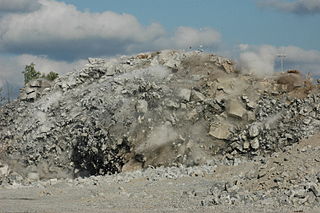
Drilling and blasting is the controlled use of explosives and other methods, such as gas pressure blasting pyrotechnics, to break rock for excavation. It is practiced most often in mining, quarrying and civil engineering such as dam, tunnel or road construction. The result of rock blasting is often known as a rock cut.
Peaceful nuclear explosions (PNEs) are nuclear explosions conducted for non-military purposes. Proposed uses include excavation for the building of canals and harbours, electrical generation, the use of nuclear explosions to drive spacecraft, and as a form of wide-area fracking. PNEs were an area of some research from the late 1950s into the 1980s, primarily in the United States and Soviet Union.
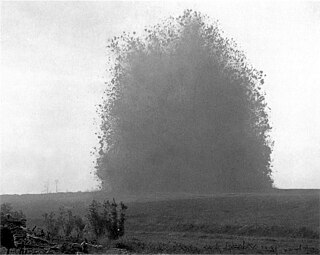
There have been many extremely large explosions, accidental and intentional, caused by modern high explosives, boiling liquid expanding vapour explosions (BLEVEs), older explosives such as gunpowder, volatile petroleum-based fuels such as gasoline, and other chemical reactions. This list contains the largest known examples, sorted by date. An unambiguous ranking in order of severity is not possible; a 1994 study by historian Jay White of 130 large explosions suggested that they need to be ranked by an overall effect of power, quantity, radius, loss of life and property destruction, but concluded that such rankings are difficult to assess.

The Beaconsfield gold mine collapsed on 25 April 2006 in Beaconsfield, Tasmania, Australia. Of the seventeen people who were in the mine at the time, fourteen escaped immediately following the collapse, one miner was killed and the remaining two were found alive on the sixth day by miners Pat Ball and Steve Saltmarsh. Webb and Russell were rescued on 9 May 2006, two weeks after being trapped nearly 1 kilometre (0.62 mi) below the surface.
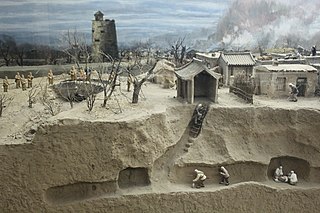
Tunnel warfare involves war being conducted in tunnels and other underground cavities. It often includes the construction of underground facilities in order to attack or defend, and the use of existing natural caves and artificial underground facilities for military purposes. Tunnels can be used to undermine fortifications and slip into enemy territory for a surprise attack, while it can strengthen a defense by creating the possibility of ambush, counterattack and the ability to transfer troops from one portion of the battleground to another unseen and protected. Also, tunnels can serve as shelter from enemy attack.
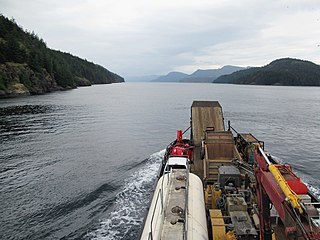
Seymour Narrows is a 5-kilometre (3.1 mi) section of the Discovery Passage in British Columbia known for strong tidal currents. Discovery Passage lies between Vancouver Island at Menzies Bay, British Columbia and Quadra Island except at its northern end where the eastern shoreline is Sonora Island. The section known as Seymour Narrows begins about 18 km (11 mi) from the south end of Discovery Passage where it enters the Georgia Strait near Campbell River. For most of the length of the narrows, the channel is about 750 metres (820 yd) wide. Through this narrow channel, currents can reach 15 knots.

The Ffestiniog Power Station is a 360-megawatt pumped-storage hydroelectricity scheme near Ffestiniog, in Gwynedd, north-west Wales. The power station at the lower reservoir has four water turbines, which can generate 360 MW of electricity within 60 seconds of the need arising. The scheme has a storage capacity of around 1.44 GWh (5.2 TJ) at maximum output for four hours, and the capacity to power the whole of North Wales for several hours.

Underground nuclear testing is the test detonation of nuclear weapons that is performed underground. When the device being tested is buried at sufficient depth, the nuclear explosion may be contained, with no release of radioactive materials to the atmosphere.

Project Gnome was the first nuclear test of Project Plowshare and was the first continental nuclear weapon test since Trinity to be conducted outside of the Nevada Test Site, and the second test in the state of New Mexico after Trinity. It was tested in southeastern New Mexico on December 10, 1961, approximately 40 km southeast of Carlsbad, New Mexico.
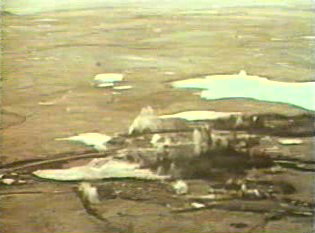
The United States's Flintlock nuclear test series was a group of 47 nuclear tests conducted in 1965–1966. These tests followed the Operation Whetstone series and preceded the Operation Latchkey series.
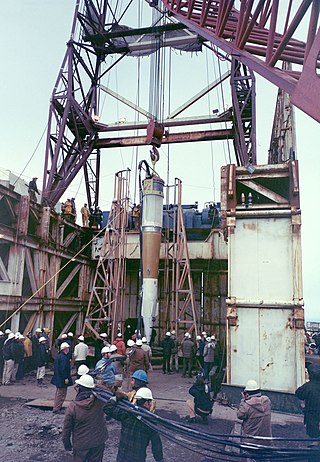
Cannikin was an underground nuclear weapons test performed on November 6, 1971, on Amchitka island, Alaska, by the United States Atomic Energy Commission. The experiment, part of the Operation Grommet nuclear test series, tested the unique W71 warhead design for the LIM-49 Spartan anti-ballistic missile. With an explosive yield of almost 5 megatons of TNT (21 PJ), the test was the largest underground explosion ever detonated by the United States.
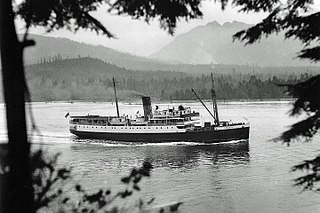
For more than 35 years, from 1923 to 1958, the Union steamship Cardena sailed the British Columbia Coast, carrying passengers, groceries, dry goods, industrial cargo, mail and sundry other supplies to the 200 or so mining, logging and fishing communities that once dotted the province's coastline during the early years of the 20th century. On her return voyage, at the peak of the summer fishing season, Cardena routinely carried thousands of cases of canned salmon to the railheads at Prince Rupert and Vancouver for shipment across Canada and around the world. And so it went for the better part of half a century; a regular and reliable marine service that made Cardena a coastal institution, remembered with affection and regard by the countless men, women and children who inhabited those tiny outports in a bygone era.
Operation Project 56 was a series of 4 nuclear tests conducted by the United States in 1955–1956 at the Nevada Test Site. These tests followed the Operation Wigwam series and preceded the Operation Redwing series.

Porto Flavia is a sea harbor located near Nebida in the Iglesias comune of South Sardinia in Italy. Built in 1923–24, it served as the mineral production hub of Masua in the west coast of the Sardinian Iglesiente area. It is named after Flavia Vecelli, the daughter of the harbor's engineer and designer Cesare Vecelli. The harbor's characteristics make it unique in the world, and at the time of its construction it was an outstanding engineering feat.

The tunnels of Gibraltar were constructed over the course of nearly 200 years, principally by the British Army. Within a land area of only 2.6 square miles (6.7 km2), Gibraltar has around 34 miles (55 km) of tunnels, nearly twice the length of its entire road network. The first tunnels, excavated in the late 18th century, served as communication passages between artillery positions and housed guns within embrasures cut into the North Face of the Rock. More tunnels were constructed in the 19th century to allow easier access to remote areas of Gibraltar and accommodate stores and reservoirs to deliver the water supply of Gibraltar.

The removal of obstructive rocks from Hell Gate, a narrow tidal strait in New York City's East River and a major water transportation route, began in 1849, when French engineer Benjamin Maillefert, cleared some of the rocks. Then in 1851, the U.S. Army Corps of Engineers, led by General John Newton, began to do the job, in an operation which was to span 70 years. On September 24, 1876, the Corps used 50,000 pounds (23,000 kg) of explosives to blast the rocks, which was followed by further blasting. The process was started by excavating under Hallets reef from Astoria. Cornish miners, assisted by steam drills, dug galleries under the reef, which were then interconnected. They later drilled holes for explosives. A patent was issued for the detonating device. After the explosion, the rock debris was dredged and dropped into a deep part of the river. This was not repeated at the later Flood Rock explosion.



















